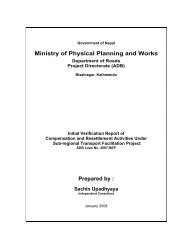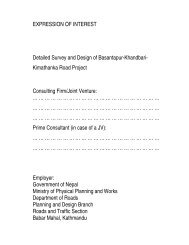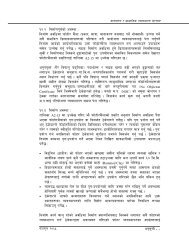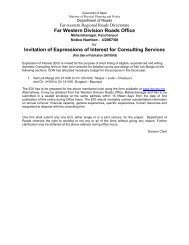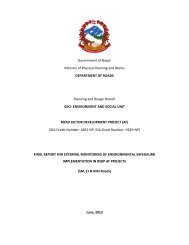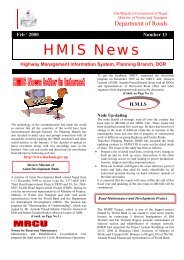Environmental & Social Management Framework - About ...
Environmental & Social Management Framework - About ...
Environmental & Social Management Framework - About ...
You also want an ePaper? Increase the reach of your titles
YUMPU automatically turns print PDFs into web optimized ePapers that Google loves.
<strong>Environmental</strong> and <strong>Social</strong> <strong>Management</strong> <strong>Framework</strong>Access to inputs and services is severely constrained without suitable roadtransportation facilities. In most of Nepal’s remote areas, porters and mules arethe only means of transporting any input or output in the area. As a result ofdifficult and expensive access, the use of inputs and services is far below thepotential in all sub sectors of the economy such as agriculture, horticulture andlivestock and, to lesser extent, handicraft products.Once the road comes into operation, people will have improved access to manyinputs such as seeds, chemical fertilizer, irrigation and technology leading toincreased agricultural production and diversification. Crop investment andoperation costs are expected to become considerably reduced. Same would bethe case for marketing the local products, which have experienced difficult accessto get into the bigger markets. This will enhance economic activities within thearea through the increase of employment opportunities and income level. Theservice sector will equally benefit from improved road access. This will includesetting up new educational facilities in private and public sector, andimplementation of health, hygiene and drinking water programs by governmentand NGOs. The operation of road will also contribute to raise quality services insocial sector as more competent agencies and people will enter into the area toprovide the services. Road transportation will also encourage students to enrol inhigher grades at campus level, which will become possible after the operation ofregular vehicles along the road. Students can attend classes even in distantareas after efficient transportation service. Qualified doctors and other serviceproviders will be encouraged to stay in the area.4.2.7 Gender-Specific BenefitsRoad transportation will benefit local women by providing improved access tomarket facilities. Mobility will considerably increase while more efficient roadtransportation systems will be in place. Women, in specific, may therefore get intoa better position to attend various service agencies such as hospitals, healthclinics, training institutes, women development programs etc. More frequent visitto such organizations will increase women's knowledge and awareness level. Girlstudents will be encouraged to go to schools that will become easier accessible.In Nepal, road development in rural areas will thus contribute to women’sempowerment and facilitate their struggle in escaping widespread discriminationand economic disadvantages.4.2.8 Exploitation of Untapped PotentialImproved road connectivity will provide access to sites insofar recognized for theircultural scientific, historic, scenic and social values but practically secluded fromprospering from these values. This holds particularly true for the potential todevelop tourism that will both geared towards environmental education and tobring economic opportunities to the local area.4.2.9 Poverty AlleviationCase studies analyzed in the ADB special evaluation (IES: REG 2003-15) TheImpact of Rural Roads on Poverty Reduction October 2002 showed that roadaccess significantly alleviated poverty by improving economic opportunities andaccess to services. However, benefits varied depending on the geographicalcontext, such as the regional economy, agricultural potential, proximity totransport networks, world market prices, availability of services, as well as socialstructure and concentration of assets.April 2007 Chapter 4-5



![j:6 ]zg cfof ]hgf](https://img.yumpu.com/51286794/1/190x245/j6-zg-cfof-hgf.jpg?quality=85)

![x'nfsL /fhdfu { cfof ]hgf](https://img.yumpu.com/50581959/1/190x245/xnfsl-fhdfu-cfof-hgf.jpg?quality=85)
